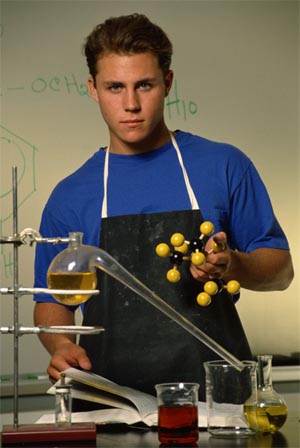|
 |
| Teachers.Net Gazette Vol.6 No.5 | May 2009 |
Subscribe for free home delivery |
|
How to Increase the Number of Physics and Chemistry Majors There is a great untapped potential of minority students, average students and females, in the inner cities of this country who could become physics teachers and physicists, chemistry teachers and chemists, if only they could be turned on to a career in physics, chemistry and engineering. | ||
| by Stewart E Brekke, MS in Ed, MA Continued from page 1 May 1, 2009 |
||
 During the cold war the number of physics majors was high. Unfortunately, those college courses in the 60’s and 70’s were not user friendly and a virtual “bloodbath of physics and engineering failures” took place. While there were many majors in physics and related subjects, such as engineering, the number of actual graduates was far less in those majors, especially in the large state universities. I found many at risk students, average to honors, could easily do the standard mathematical physics and chemistry course with varying degrees of help. I was able to empower these students to be able to solve a standard high school physics and chemistry problem and thereby be prepared for a mathematical college freshman course. We need to employ the principles of learning instead of erroneously stressing so called “thinking” (a euphemism for actually making physics at all levels unnecessarily hard). Learning should be the emphasis in physics to keep and encourage physics majors, and not unnecessarily emphasizing struggling with the problems. To be honest, to keep those college physics and chemistry majors, the college physics and chemistry texts need to be made more user friendly besides the teaching of those subjects themselves. Often, the problem solving aspect of the course, the main and most effective manner of teaching and learning physics and chemistry, has become a dreaded endeavor for the student, from the most competent to average, because the problems often have no example in the text, and most students cannot solve even basic physics and chemistry problems without some kind of outside help. In fact a vast multimillion dollar industry has arisen in which physics, engineering and other technical mathematical problem solvers such as the wonderful Shaum’s College Outline Series provide insights into the solution of physics and chemistry problems, which could easily be solved if an example problem is given in the text. These physics texts often give hard problems under the erroneous pretext of raising the thinking capacity of the student, when in reality the student rarely does any thinking of that type to solve the problem. Mostly, the students look for an example of how to do the problem in a physics or a chemistry problem-solver, or get someone such as a friendly professor or a paid tutor to solve the problem. Today a vast tutoring industry is developing across the nation. A few years ago I took an advanced physics course and hired a tutor twice a week at $20/hr to help me pass the course. I passed with an A, my time was maximized, and I learned quite a bit. In high school I interacted with a student of another teacher who spent six hours at home trying to solve a problem, which I showed her how to do in two minutes. An example in the text would have saved his young minority student six hours of wasted effort which if repeated again and again would have certainly turned her off on mathematics, a field in which she could make a decent wage if she majored in it. In summary, we need to make high school and college physics and chemistry, graduate to undergraduate, more user friendly if we are to increase the number of physics and chemistry major. However, to increase the number of physics and chemistry majors is not enough. We must actually graduate a larger number of those initial physics and chemistry majors though better texts that employ the basic principles of learning, such as more examples of problems to be solved in the texts and the increased use of drills and practices of those problems. We must also target more minority students, Black and Hispanic, and in all areas we must target average students and young women in the high schools. To reach these traditionally at-risk students in high school, where interest in physics and chemistry begins, we must make these traditionally “hard” courses much more user friendly. | ||
|

